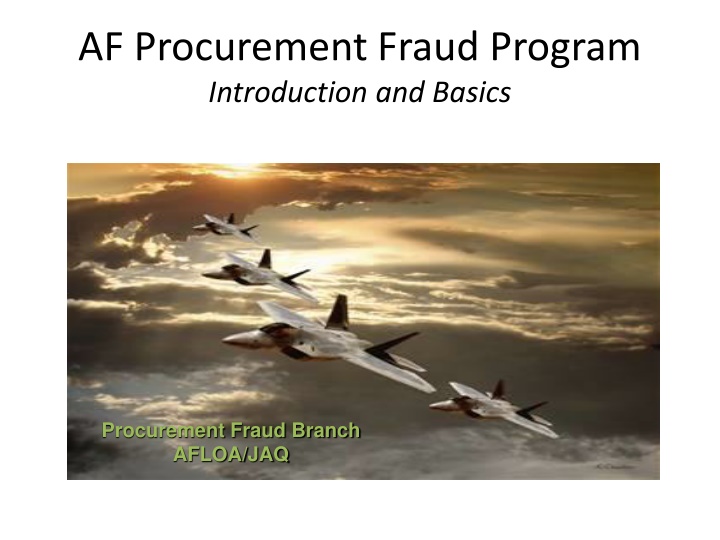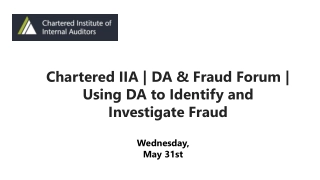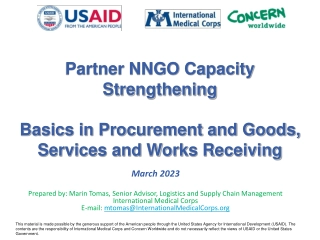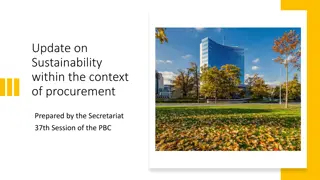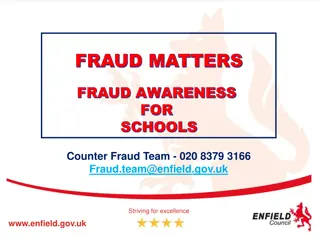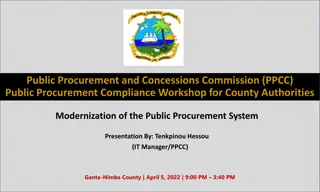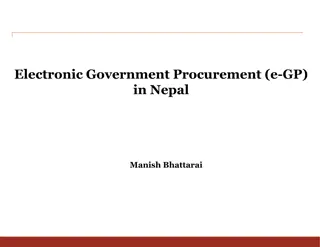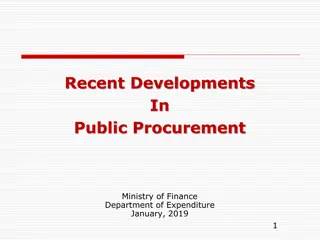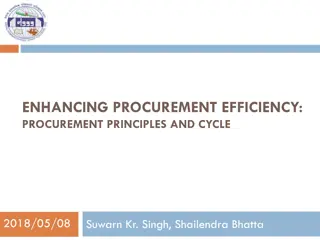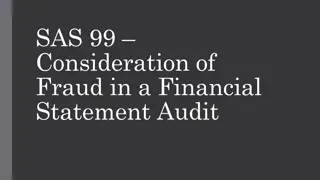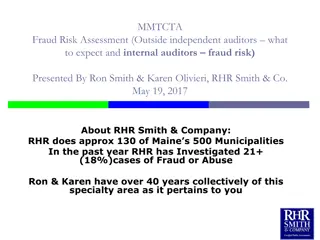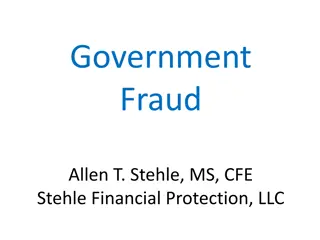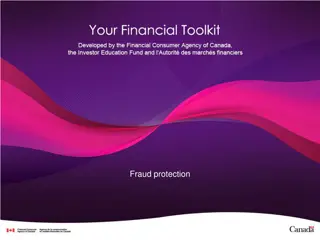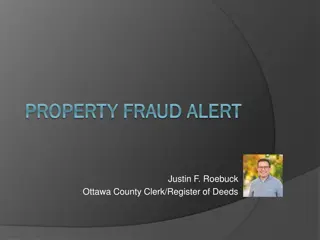Introduction to AF Procurement Fraud Program
This program aims to educate, train, and reinvigorate AF procurement fraud remedies to save taxpayer/AF funds, prevent fraud, waste, corruption, and ensure funds are well spent. The mission is to prevent, detect, deter, and remedy fraud/corruption, preserve government integrity, ensure transparency, fairness, and accountability, and protect taxpayer interests and national security.
Download Presentation

Please find below an Image/Link to download the presentation.
The content on the website is provided AS IS for your information and personal use only. It may not be sold, licensed, or shared on other websites without obtaining consent from the author.If you encounter any issues during the download, it is possible that the publisher has removed the file from their server.
You are allowed to download the files provided on this website for personal or commercial use, subject to the condition that they are used lawfully. All files are the property of their respective owners.
The content on the website is provided AS IS for your information and personal use only. It may not be sold, licensed, or shared on other websites without obtaining consent from the author.
E N D
Presentation Transcript
AF Procurement Fraud Program Introduction and Basics KEYSTONE KEYSTONE Procurement Fraud Branch AFLOA/JAQ
Why are we here? Educate and Train Reinvigorate the AF procurement fraud remedies program outside of AFMC Note that this is about much more than just procurement fraud More broadly doing better business, weeding out non-responsible suppliers, shoring up internal controls to prevent fraud, waste, and corruption (see FAR 1.602-2) Save taxpayer/AF funds in era of fiscal limitations Or at least be positioned to say that we re doing everything we can to ensure that funds are well spent & investments well protected Not about beating up on contractors Not about seeing fraud under every rock Very important to distinguish between fraud/corruption and contractor (or Government) incompetence and mistakes
The Big Picture: What is the mission? Prevent, detect, deter, & remedy fraud/corruption Preserve integrity of Government acquisition process Transparency, fairness, and accountability (inside and out) Protect taxpayer interests and money! Protect national security (counterfeit parts, etc.) Defend /preserve AF business interests Work with responsible/ethical/capable contractors (cf. FAR 9.4) Foster fair and robust competition for Gov t requirements Ensure that we get what we paid for supply or service Acquisition Integrity! 3
Also in the news How could a contracting scam avoid detection for so long? The Washington Post (Dec 24, 2011) Private contractors and government employees skimmed millions from the Army Corps of Engineers in what authorities have described as one of the most brazen contracting scams in federal government history. From 2007 through September, the contractors and two program managers at the Army Corps inflated $25 million in contract orders by $20 million Starting in 2007, the two Corps program managers and [a Contractor employee] began steering work to a Chantilly-based firm identified in court papers as Company A. That company s chief technology officer then began filing inflated invoices for work to EyakTek [the prime contractor - an Alaska Native Corporation], which passed the bills to the government The conspirators also were working to ensure that the government s statement of objectives for the work were tailored to favor that firm Part of the problem, contracting specialists say, was that the Army Corps program managers were high enough in the organization that there was no one to check their work. **** 4
JAQs Evolving Role Previously Three attorneys (1 Lt Col, 1 Maj, 1 civilian) Provide reach back expertise for procurement fraud cases Provide training to Acquisition Fraud Counsel (AFC) and CONS Coordinate with OSI, AFC, SAF/GCR, Asst US Attorneys (AUSAs) Prosecute in select UCMJ cases Going Forward 4-5 attorneys (1 Lt Col, 2-3 Maj, 1 civilian) Primary advisors to OSI fraud investigators Provide joint JAQ/OSI training to OSI agents, CONS, JA personnel Closely coordinate and assist on AUSA case briefings Coordinate with base AFC on fraud investigations Increased support on prosecuting, potentially as SAUSAs
AFI 51-1101 AF Procurement Fraud Remedies Program Detect and correct procurement fraud across the AF in a coordinated and efficient manner SAF/GCR has overall coordination responsibility Acquisition Fraud Counsel (JAG Corps attorneys) are key facilitators (installation, MAJCOM, and now AFLOA/JAQ) Remedies plans Assist/advise COs in implementation of contractual remedies Training Other key stakeholders: AFOSI, contracting personnel, CORs/QAEs, requiring activity personnel, DCAA, DOJ, IG MOU (9 Dec 2011) SAF/AQC, SAF/GCR, AFOSI cooperative effort to fight fraud
Common Problem Areas & Problem Signs/Red Flags Where there is smoke, there MIGHT be fire
Problem Signs/Red Flags Is this fraud? Or something else? Problem signs (often referred to as fraud indicators ) are signs or clues that a contractor (or a Government employee) may be engaging in fraudulent or non-responsible conduct. Contractor in poor financial condition Complaints from subs / non-payment of subs or suppliers Contractor slow in producing requested documentation Irregularities in accounting/billing Duplicate invoices or payments Government and contractor personnel not operating at an arms length
Problem Signs/Red Flags When identifying the need or requirement Inadequate or vague need assessment Need determination appears unnecessarily tailored in ways that can only be met by certain contractors Urgency of need (required time frame for acquisition) appears questionable In development of specifications and SOW/PWS Contractor involvement in writing specs or SOW w/o proper precautions concerning conflicts of interest Requirement seems to match products/capabilities of specific contractor Gov t employee providing preferred contractor(s) with advance information concerning requirements and pending contracts (potential Procurement Integrity Act violation) Specifications seem unnecessarily restrictive Requirements seem to be split unnecessarily to lower cost and avoid supervision/oversight
Problem Signs/Red Flags Other pre-solicitation issues Sole source justification appears unnecessary or is poorly supported Market research seems inadequate to properly establish evaluation factors, determine contract type, determine whether COTS solution could satisfy Government s needs, etc. Solicitation issues Time for submission of bids/proposals is restricted so that only a certain contractors (those with advance notice?) have adequate time to submit bids/proposals Evidence of improper communications or social contact between Gov t employees and contractors Customer regularly recommends (or demands?) a particular supplier or subcontractor Contractor makes false statements during pre-award survey (i.e., regarding qualifications, capabilities, etc.)
Problem Signs/Red Flags Submission of bids Withdrawal by a low bidder who later becomes subcontractor to high bidder Apparent collusion or bid rigging among the bidders Competing contractors seem to win bids on rotating basis Losing contractors bids somehow always just too high to be acceptable Winning bidders often subcontract with competitors Required contractor certifications appear falsified Small business certification Buy-American Act certification Certification of independent price determination
Problem Signs/Red Flags Evaluation of bids and proposals CO accepts bids that appear to be nonresponsive CO disqualifies otherwise qualified offeror(s) w/o proper justification Gov t employee reveals offeror rankings or fails to adequately/ appropriately protect IGCE, source selection information, etc. -- giving one contractor an unfair competitive advantage Contract award CO allows apparent winning bidder to withdraw w/o justification Award goes to contractor with documented history of poor performance Gov t personnel receive gifts from winning bidder
Problem Signs/Red Flags During Contract Performance Contract compliance Supplies not delivered; work not completed Use of unqualified personnel in services contracts Contractor regularly requests contract modifications Contractor accounting False or inaccurate invoices (or supporting documentation) History of invoicing errors and poor documentation No third party documentation Ghost employees; phantom vendors Frequent turnover of individuals preparing invoices Contractor is very slow to turn over supporting documentation Contractor appears to be running up material charges (cost plus)
Problem Signs/Red Flags During Contract Performance (continued) Contractor Accounting Cost mischarging Contractor transferring labor costs from FP contracts to cost contracts or from commercial contracts to Government contracts Labor and time charges seem inconsistent with project progress Contractor appears to be substituting inferior materials (i.e., not meeting specs) while charging full price Quality Control Test reports/certifications appear to be altered and/or contractor isn t complying with test procedures As evidenced by repeated test failures, etc. Certification forms appear to have been pre-signed Contractor comingles tested/untested parts ( salting )
Bribery, Kickbacks, and Gratuities Contractor offers monetary payment or other compensation in exchange for favorable consideration in contract award or during contract oversight a REALLY obvious Red Flag Frequent and apparently unnecessary visits by contractor to purchasers/suppliers/subs Contractor entertains purchasers/suppliers/subs Gov t employee or member of immediate family has a direct financial interest with the contractor or affiliate, such as stock ownership, officer of entity or employment of family member Gov t employee owns or works for outside company that does business with Government contractors
Key responsibilities for contracting personnel Understand and enforce contract requirements Be alert for problem signs / contract irregularities Ask questions contractor, QAE, attorney, auditor, etc. Follow-up on notices of potentially defective products/services Establish strong working relationship with contracts attorney/ acquisition fraud counsel!! Talk to him/her about problem signs, red flags, etc. Report wrongdoing (generally to AFOSI) Do not wait for proof Investigators are there to collect evidence and conduct investigations
Typical Installation-Level Cases Small business acts as front or pass through for a large business that does majority of the work Violates various SBA rules & contract clauses (i.e., FAR 52.219-14) Gov t personnel disclose IGCE to contractors Dual culpability Contractor bills for services never accomplished Indicates a COR problem Construction contractor bills for work that doesn t comply with specs Indicates a COR problem Contractors take turns winning awards (collusion) 17
Coordinating Remedies: What s the Point? Mere mention of fraud does not mean CO s ability to implement remedies is automatically restricted Rule: CO cannot take action that may prejudice pending or potential fraud litigation or constitute settlement of fraud matter However, agencies can and should consider implementing administrative & contractual remedies whenever such remedies are appropriate AF can often get prompt/beneficial results (funds returned on the contract, contractor debarred, etc.) via administrative and contractual remedies even during the pendency of a civil or criminal case Stakeholders (Contracting, customer, AFOSI, DOJ, etc.) have to coordinate to be able to pull this off
Administrative Remedies: Suspensions & Debarments Administrative measures used to ensure that the Government does business only with responsible contractors (FAR 9.4) Protects Government and integrity of the procurement process Not punishment but obvious, immediate collateral consequences Contractors found Not PresentlyResponsible may be suspended or debarred Can result from fraudulent or other illegal activity or from poor contract performance Focus on the contractor s honesty, integrity, ethics, responsibility, competence, among other factors Judgments / Convictions are not necessary
Suspension and Debarment (cont.) Suspension Facts still being developed through investigation or legal proceedings Used when immediate action needed to protect Government s interests Length: Maximum of one year unless extended due to criminal/civil proceedings Based on adequate evidence Debarment Basis: Investigation or legal proceeding concluded (conviction or civil judgment), OR Where the facts, by a preponderance of evidence, prove improper conduct Length: For time period specified by the Suspension & Debarment Official (SDO) generally three years
Suspension and Debarment (cont.) Procedure: Notice to Contractor Contractor response dispute or concede facts If factual dispute: Discovery and mini-trial (administrative) All handled by SAF/GCR! What s required of the Contracting Officer? Talk to your contracts attorney / fraud counsel Provide the factual support for the alleged misconduct Contract documents, memos, e-mails, etc. Remember that misconduct can include a willful failure to perform or repeated poor performance (on one or more contracts) Fraud counsel (either locally or at AFLOA/JAQ) will assist with putting together the referral package (to SAF/GCR)
Suspension and Debarment (cont.) Suspended or debarred contractors are not eligible for award of new (future) Government contracts Contractor obligated to complete previously awarded contracts Government may not exercise options on existing contracts Government may not modify existing contracts to extend performance period of add work Excluded Parties List System Bottom line: An important remedy w/in AF control Helps investigators contractor incentivized to disclose facts quickly i/o to keep business running/maintain cash flow Show cause letters(i.e., tell me why I shouldn t immediately suspend/debar you ) can be a useful tool staffed up to SDO through fraud counsel
Recent DoD IG Audit Report Report No. D-2011-083 (July 14, 2011) Finding B. Contracting Officer Involvement in the Suspension & Debarment Process Could Be Improved .The Services contracting personnel had little to no involvement in the Suspension and Debarment (S&D) process and did not refer poorly performing contractors to the S&D officials for fact-based suspensions and debarments . As a result of the Services contracting officers potentially not referring as many poorly performing contractors to the S&D officials for suspension or debarment, poorly performing contractors may still be receiving Federal contracts.
Contractual Remedies - Examples Cost Mischarging Improper allocation of costs, charging of unallowable costs, or artificially inflating costs resulting in overcharging for goods and services Engage call out the contractor Price/Cost adjustment Withhold Contract Payments (FAR 32.612) Disallowance of Contract Costs (FAR 42.8) FAR 32.6 Contract Debts
Contractual Remedies - Examples Failure to Meet Contract Specifications (contractor represents that specifications have been met) Cure Notice/Show Cause (FAR Part 49) Termination (FAR Part 49) Unilateral Price Reduction (FAR 43.103(b)) Suspend/Reduce Progress Payments (FAR 32.503-6) Revoke Acceptance Latent Defect (FAR 52.246-2) Contractor Correct/Replace at no charge to Gov t (FAR 52.246-3)
Contractual Remedies - Examples Product Substitution Intentional submission of goods and/or services that do not conform to contract specifications or requirements Reject Product or Service (FAR 52.246-2) Cure Notice/Show Cause Post-Acceptance Latent Defect Contractor Correct/Replace at no cost to Gov t Termination
Contractual Remedies Past Performance assessments Past performance information is relevant information, for future source selection purposes, regarding the contractor s actions under previously awarded contracts. It includes, for example, the contractor s record of conforming to contract requirements and to standards of good workmanship . . . and generally, the contractor s business-like concern for the interest of the customer. FAR 42.1501 This is the bare minimum requirement for addressing poorly performing/corrupt/unethical contractors
The Basics: Definition of Fraud Legal definition three elements: 1) Misrepresentation 2) of a Material Fact 3) with the Intent to Deceive Includes: Deliberate omission of material facts False or misleading representations Practically speaking: lying, cheating, stealing By a contractor employee or a Government employee (or both) Always look for the lie
Criminal vs. Civil Cases (DOJ owns both) Criminal Civil Required Intent : Actual knowledge Reckless disregard/ (knowledge of the fraud) deliberate ignorance Burden of Proof: Beyond a reasonable doubt Preponderance of the evidence Discovery process: Grand jury Depositions Remedies: Imprisonment/ Fines/Restitution Damages/ Penalties
Civil Statute False Claims Act (31 USC 3729) Principal prohibitions: Knowingly presenting, or causing to be presented to the Government a false claim for payment (includes such things as invoices, work orders, etc.); Knowingly making, using, or causing to be made or used, a false record or statement to get a false claim paid/approved by the Government; Conspiring to defraud the Government by getting a false claim allowed or paid;
Civil Prosecution False Claims Act Imposes up to treble damages and civil fines of $5,500 to $11,000 per false claim Establishes preponderance of the evidence" standard for all elements of the claim - including damages Establishes liability for "deliberate ignorance" and "reckless disregard" of the truth No specific intent to defraud required Defendant pays successful plaintiff's expenses &attorney's fees
Qui Tam suits Private litigant ( relator ) may sue alleged perpetrator of fraud under False Claims Act in name of United States Cases filed under seal (existence of suit not disclosed to defendant) Litigant entitled to share of any recovery DOJ may intervene (60 days) in order to take the lead on the case investigation by Government necessary to determine validity of case If DOJ does not intervene, relator may proceed on his/her own
Final Take-Aways Red flags can indicate a variety of things not just fraud Use business judgment in deciding what to do Get your fraud counsel (contracts attorney) involved early Outright fraud and corruption aren t the only concerns Waste & inefficiency in acquisition/contracting takes many forms Contractor responsibility (FAR 9.4) When fraud/corruption is uncovered, remember that you have a range of potential remedies However, coordinate before you act! Lean on your contracts attorney/fraud counsel! Administrative remedy can be a very powerful tool
